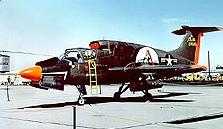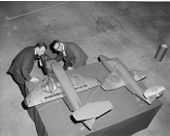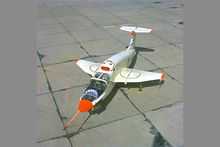Ryan XV-5 Vertifan
| XV-5 Vertifan | |
|---|---|
 | |
| Role | VTOL |
| Manufacturer | Ryan Aeronautical |
| First flight | 25 May 1964 |
| Status | Retired |
| Primary users | United States Army NASA |
| Number built | 2 |
|
| |
The Ryan XV-5 Vertifan was a jet-powered V/STOL experimental aircraft in the 1960s. The U.S. Army commissioned the Ryan VZ-11RY (which was redesignated as the XV-5 in 1962) in 1961, along with the Lockheed VZ-10 Hummingbird (redesignated as the XV-4).
Design

The XV-5 was powered by two 2,658 lbf (13 kN) thrust J85 turbojets, similar to those used in the F-5 Freedom Fighter. Lift-fans in the wings and a smaller fan in the nose, powered by engine exhaust gas, were used for VTOL. It may be contrasted to the future F-35 Lightning II which has one fan driven by a driveshaft, balanced by a rotating rear nozzle. The 62.5 inch diameter[1] lift fan in each wing had a hinged cover on the upper wing surface which was opened for VTOL. The 36 inch (0.9 m) nose fan provided adequate pitch control but produced adverse handlling characteristics.[2] The fans provided vertical lift of approximately 16,000 lbf (71.2 kN), nearly three times the thrust of the engines as turbojets.[3]
A set of louvered vanes underneath each of the wing fans could vector the thrust fore and aft and provided yaw control. The engine power setting determined the lift from the fans. Fan RPM was determined by the output from the J85 engines and the load on the fan.[2] Roll control was by differential actuation of the wing-fan exit louvers.
Aircraft performance was subsonic, with delta wings superficially similar to those on the A-4 Skyhawk. The Vertifan had an unusual intake position above the two-seat side-by-side seating cockpit, and a T-tail.
The XV-5A was finished in Army green and the XV-5B was painted in white NASA colors. The fans did not generate as much thrust as was hoped, and the vertical-horizontal flight transition was difficult and abrupt. The XV-5 would be one of the last manned aircraft designed and built by Ryan, which mainly manufactured drones after the mid 1960s.
The XV-5 was one of many dozens of aircraft which attempted to produce a successful vertical takeoff aircraft, but the lift fan system was heavy and occupied considerable internal volume. Only the Hawker Siddeley Harrier would still be operational by the turn of the 21st century, as would technology to make possible the use of a shaft-driven fan in the F-35.
Propulsion system
The General Electric J85 and lift-fan combination, two of which were used in the Vertifan,was the precursor to developments which led to the first GE high BPR engine, the TF-39.[4] The lift fans were driven by turbine blades mounted around the periphery of the fan. The J85, driving this large-diameter fan, which moved 13 times[4] the gas generator flow, increased thrust 3 times over that available using a propelling nozzle.
After demonstrating that large amounts of air could be moved through a lift fan an 80 inch fan turned through 90 degrees, tip-turbine driven by a more powerful J79 engine, was built to demonstrate an efficient cruise fan.[5] The concept of a large diameter cruise fan was incorporated in the TF-39 engine.
Operational history


Two 12,500 lb (maximum gross weight) XV-5A were evaluated in late 1966 by fifteen test pilots (the "XV-5A Fan Club"). One was destroyed in a crash during a public flight demonstration on 27 April 1965, killing Ryan test pilot Lou Everett. Tests and promotional materials proposed a rescue version that could winch a person into a compartment behind the pilots. The second aircraft was extensively damaged in 1966 during trials as a rescue aircraft, when the test dummy was ingested into a wing fan. The pilot, Bob Tittle, was fatally injured, although it was judged that the fan actually still functioned well enough to continue controlled flight. The second aircraft was rebuilt as the modified XV-5B, with tests continuing until 1971. An XV-5B can be seen on display at the Fort Rucker Aviation Museum, Alabama.
Specifications (XV-5) (performance estimated)
Data from Jane's All The World's Aircraft 1965–66[6]
General characteristics
- Crew: 2
- Length: 44 ft 6 in (13.56 m)
- Wingspan: 29 ft 10 in (9.09 m)
- Height: 14 ft 9 in (4.5 m)
- Wing area: 260.3 sq ft (24.18 m2)
- Empty weight: 7,541 lb (3,421 kg)
- Max takeoff weight: 13,600 lb (6,169 kg) (conventional takeoff), 12,300 lb (5,579.2 kg) (VTOL)
- Powerplant: 2 × General Electric J85-GE-5 turbojet with selectable exhaust driven lift fans, 2,658 lbf (11.82 kN) thrust each horizontal thrust, 7,430 lbf (33.1 kN) VTOL thrust from lift fans
Performance
- Maximum speed: 475 kn; 880 km/h (547 mph)
- Service ceiling: 40,000 ft (12,000 m)
- Rate of climb: 8,000 ft/min (41 m/s)
See also
- Aircraft of comparable role, configuration and era
- Related lists
References
- Notes
- ↑ "VZ-11 VTOL Lift From Fans In The Wings" Flight International, 27 September 1962
- ↑ 2.0 2.1 "Lift-Fan Aircraft-Lessons Learned The Pilot's Perspective" Ronald M. Gerdes, NASA Contractor Report 177620August 1993
- ↑ Taylor, John W.R. FRHistS. ARAeS (1962). Jane's All the World's Aircraft 1962-63. London: Sampson, Low, Marston & Co Ltd.
- ↑ 4.0 4.1 "The Power to Fly"Brian H. Rowe, Pen & Sword Aviation,ISBN 1 84415 200 6
- ↑ "Seven Decades of Progress" General Electric, Aero Publishers Inc. ISBN 0-8168-8355-6
- ↑ Taylor, John W.R. FRHistS. ARAeS (1965). Jane's All the World's Aircraft 1965–66. London: Sampson, Low, Marston & Co Ltd.
- Bibliography
- Taylor, John W.R. FRHistS. ARAeS (1962). Jane's All the World's Aircraft 1962-63. London: Sampson, Low, Marston & Co Ltd.
- Taylor, John W.R. FRHistS. ARAeS (1965). Jane's All the World's Aircraft 1965–66. London: Sampson, Low, Marston & Co Ltd.
External links
| Wikimedia Commons has media related to XV-5 Vertifan. |
- V/STOL: The First Half-Century. Augmented power plant for hover Partial specifications
- Immenschuh, William T. V/STOL by Vertifan Flight International, October 1964
- "600-m.p.h. Vertifan Jet Can Hover Like a Copter." Popular Science, September 1966, pp. 69–73.
- XV-5 photos and drawings at San Diego Air & Space Museum Archives
- Lift-fan aircraft – Lessons learned from XV-5 flight experience Gerdes, Ronald M. (SYRE; NASA, Ames Research Center, Moffett Field, CA) AIAA-1993-4838 IN:AIAA International Powered Lift Conference, Santa Clara, CA, 1–3 Dec 1993, Technical Papers (A94-16426 02–05), Washington, American Institute of Aeronautics and Astronautics, 1993
- Why not put lift fans in the wings? Dr. Raymond L. Puffer, Air Force Flight Center historian
- VZ-11 - VTOL Lift from Fans in the Wings a 1962 Flight article
- Test flight video on youtube
| ||||||||||||||||||||||||||
| ||||||
| ||||||||||
| ||||||||||||||||||||||